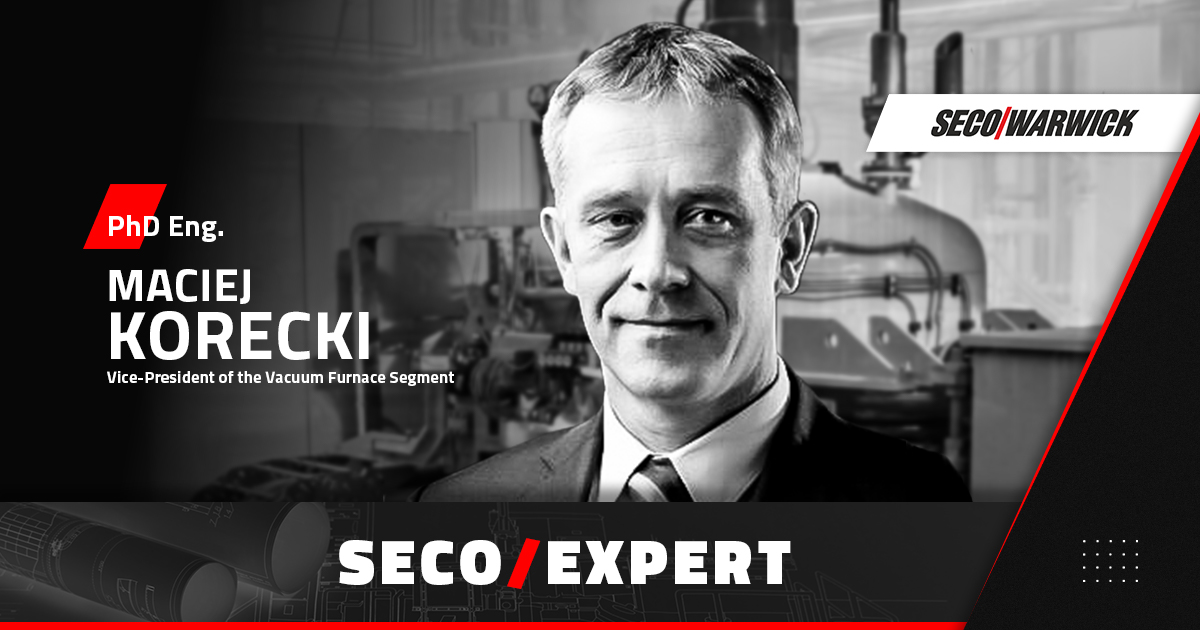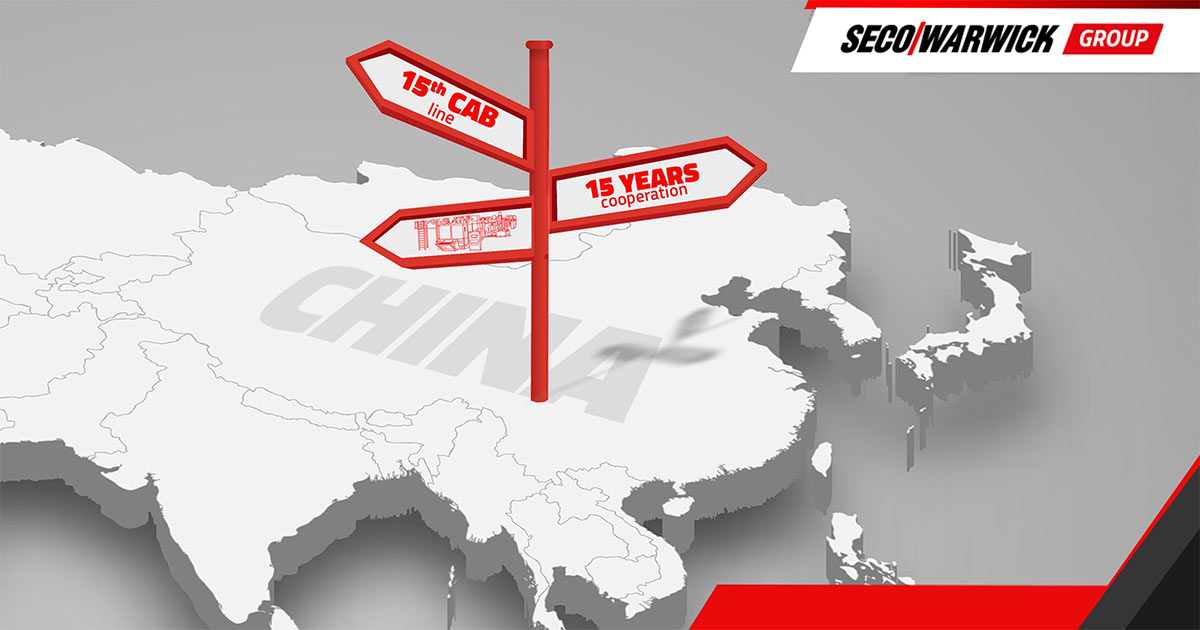The key to achieving the goals that enterprises strive for, increasing production efficiency while cutting costs, is the application of the unique Pit-LPC® technology, a highly efficient alternative to gas carburizing.
An inventor and advocate of vacuum heat treatment at the SECO/WARWICK Group, Maciej Korecki, PhD Eng., Vice-President of the Vacuum Furnace Segment, explains why the Pit-LPC furnaces have set the new direction for carburizing processes for those who will benefit the most from this technology.
What is the LPC technology and how was it developed?
Maciej Korecki: The LPC abbreviation is an acronym for the “Low Pressure Carburizing” formula, namely low-pressure carburizing, in other words under-pressure or in a vacuum, in an oxygen free atmosphere by means of hydrocarbons. The technology was developed out of the need for a solution which will be more effective and at the same time more cost efficient than traditional atmosphere carburizing. Atmosphere carburizing is a traditional technology, proven in numerous production enterprises. It has, however, certain constraints. To overcome them, we have developed at SECO/WARWICK an entirely novel approach to carburizing processes. Low-pressure carburizing in vacuum by means of hydrocarbons, delivers indisputable advantages over the traditional technology.
We were granted the first patents that we used in this project 20 years ago, in cooperation with scientists from the Technical University of Lodz. It is interesting to note that the furnace incorporates several SECO/WARWICK patented solutions! So today, we present a device that meets the highest safety standards and ensures extremely efficient operation in production facilities.
You mentioned that the first patents incorporated in the SECO/WARWICK project were granted 20 years ago. So, how long does it take to develop a new product for the heat treatment sector?
M.K.: This is a time-consuming, frequently strenuous process. And if we want to provide the market with the best and most reliable solutions, we must be sure that they are perfect in each and every aspect. We have already mentioned in our mission statement that ´we develop innovative products providing our clients with reliable, safe and environment-friendly solutions for heat treatment’.
More to the point, the first trials of LPC industrial applications date back to the ’70s of the last century where LPC was introduced for applications in vacuum furnaces. The breakthrough and wide spread of the LPC technology across the industry dates back to the 1990’s. This is when engineers explored the process and its dependencies extensively and when computer simulators were first developed, allowing for the precise control of the process with superior results. Each new industry solution requires many tests. Let’s not forget that we offer equipment that is frequently used to manufacture parts required in aviation, armaments or the automotive industry. These are the sectors that require the highest standards from us and to ensure them, it often takes years of experience.
What are the best advantages gained with the implementation of LPC technology-based equipment?
M.K.: This is an extremely effective and efficient technology, and at the same time precise and accurate. Pit-LPC® furnaces present significantly greater efficiency and reliability than atmosphere furnaces and allow for the application of advanced LPC technology along with all its advantages.
The Pit-LPC equipment guarantees a triad of advantages, currently the most important considering the operation of manufacturing enterprises cost reduction, production increases, and finally caring for the safety and the environment. And all of this is possible solely by running the process in a vacuum at higher temperatures. This state-of-the-art solution meets the most stringent ecological standards, while increasing work safety through the elimination of the use of flammable and explosive atmosphere. Additionally, we get high uniformity of the process, thus producing better quality of the processed detail. This is an ideal solution for companies that want to increase their production capacity without the necessity of purchasing additional equipment. These companies can typically save production space by replacing three machines with just one, since one Pit-LPC ensures the capacity of as much as three-atmosphere furnaces.
What are the benefits for the user equipped with LPC technology-based solutions?
M.K.: Most of all, the process time is reduced considerably along with energy and gas consumption, which directly translates into production cost cuts and better quality-related results compared to traditional technology. Moreover, the LPC process and vacuum furnaces are absolutely safe and do not use flammable atmospheres, therefore there is no risk of fire or explosion and open flame contrary to traditional furnaces.
Considering the low energy consumption and emissions as well as purity, LPC technology is environmentally friendly and emits no greenhouse gases (CO2). LPC in vacuum furnaces has no temperature restrictions, contrary to atmosphere furnaces where the material used allows for reasonable work in temperatures up to 920-940oC, which considerably reduces carbon diffusion speed and carburized layer formation. LPC technology is a complete and better alternative to atmosphere carburizing.
Which sectors choose LPC technology most often?
M.K.: The LPC technology itself is applied wherever carburizing is used as a process improving the mechanical properties of elements and parts of machines as well as power and movement transmission systems. In short, wherever the drivers include cost reduction, efficiency, quality and reliability, exploitation flexibility and environmentalism. The LPC technology made in SECO/WARWICK is especially popular amongst the manufacturers carburizing massive or longitudinal elements like gears, bearings, drilling tools and other elements requiring thick carburizing layers. We constantly improve this product; thus, it is applied in more and more industrial fields.
For example, atmosphere retort furnaces have long avoided LPC due to their unique feature which is the ability to expose work to air at the process temperature, a design that classic vacuum furnaces could not replicate. The Pit-LPC® solution has overcome this barrier and currently presents an advanced and comprehensive alternative to pit furnaces and their functions, bringing all of the LPC technology-related advantages into this application area. We also enjoy the advantage that allows us to tailor the solution to the needs of an individual client. In other words, the LPC equipment can be tailored in such a fashion that allows us to assemble the new equipment in the existing atmosphere furnace bay. Such a non-standard approach impacts the continuous expansion of the sectors interested in the furnaces equipped with LPC technology and our Pit-LPC furnace.
You have mentioned environmentalism. How is this field important from the perspective of SECO/WARWICK clients?
M.K.: Environmentalism is not only embedded in our SECO/ECO motto, but it is also crucial for several reasons. The first fundamental reason is the fact that an environmentally friendly attitude is important to all those who care for the fate of future generations. But we also have earthbound drivers in terms of economics. Enterprises today have certain defined emission standards; therefore, this is an essential financial factor. Moreover, environmental concerns considerably influence the image of large production enterprises. Thus, today no one will downplay environmental issues. The existing advanced technologies must be environmentally safe, this is a global trend. Environmental thought leadership regards safety, energy efficiency, low emissions, and environmental neutrality as essential in addressing climate change connected with global warming due to greenhouse gas emissions. LPC perfectly fits these requirements.
About the speaker
Maciej Korecki is a graduate of Zielonogórski University, where he received a Master of Science degree in Electrical Engineering, in 1988. He earned the academic degree of PhD Eng. at the Mechanical Department of the Technical University of Lodz in 2008 in the field of vacuum furnace design and testing. He is the author of numerous international SECO/WARWICK patents and regularly holds technical lectures at international conferences, specializing in heat vacuum treatment technology. His career started at Elterma in 1988 as a vacuum furnace service engineer. In 1991, he joined SECO/WARWICK, where he gained competencies in the technique and processes as well as development and innovation, specializing in vacuum carburizing and high-pressure gas quenching.
Currently, he serves as the Vice-President of the Vacuum Furnace Segment, appointed by the Board of SECO/WARWICK in 2012. PhD Eng. Maciej Korecki actively promotes the development and improvement of vacuum heat treatment equipment and processes as well as their applications in new industry and technology areas. He is an inventor and advocate of vacuum heat treatment with the „single-piece flow” method.




